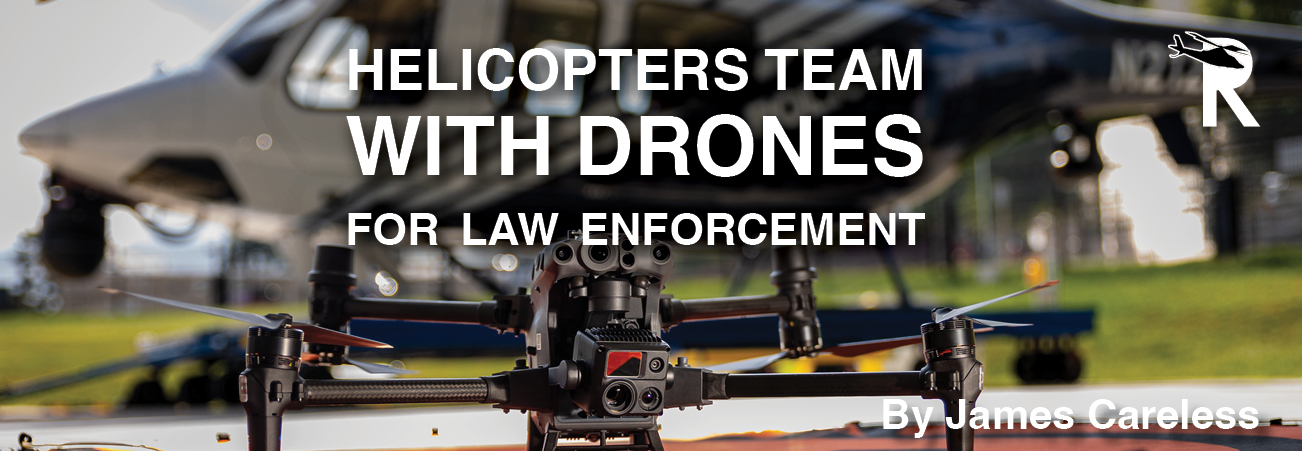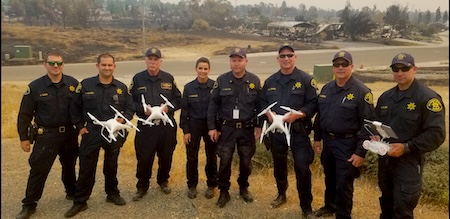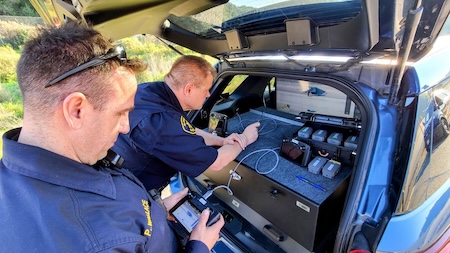|
Aug
12
2024
|
|
Posted 1 years 158 days ago ago by Admin
|
|

Drones and helicopters seem like a marriage made in heaven for law enforcement agencies. Judging by the experiences of the Alameda County (Calif.) Sheriff's Office and the Fairfax County (Va.) Police Department, it is. Both departments are teaming their crewed and uncrewed aerial assets to great success. Here is what they are doing, and how they are making the most of drones and helicopters working together.
The Players
The Alameda County Sheriff's Office's (ACSO) aircraft roster consists of a Bell 505 rotorcraft and two Cessna 206 fixed-wing aircraft. On the uncrewed side, "ACSO is equipped with various types of drone manufactured by DJI," said Sergeant John Cota of the ACSO UAV unit. "We use the Matrice 210, 300 and M30T series drones. We also operate the Mavic 2 Enterprise Series (Dual, Zoom, Advanced, Mini) and Phantom 4 drones." All of these drones are ground controlled, with those pilots coordinating their actions with ACSO's helicopter pilots.
The Fairfax County Police Department (FCPD) has Bell 429 Global Rangers and a diverse fleet of drones. “Our workhorses are DJI M30s,” said Captain Brian Bowman. “We have 12 DJIs including Mavic 2s, 3s, and Avatas. We also have seven Autels, eight Lokis (SWAT interior ops) and one Parrot Anafi.” The FCPD has flown drones since 2019, all of which are piloted by ground-based controllers.
"In recent years, our Helicopter Division has embraced advancements in UAS technology, integrating drones into our operations for enhanced situational awareness and operational capabilities," said Bowman. "For instance, our division has introduced a full-time sworn drone program manager, working under the same roof as manned operations. The collaboration between manned and unmanned aviation assets streamlines communication and coordination during operations. By centralizing drone operations within the Helicopter Division, Fairfax County ensures a unified approach to public safety aviation, where both manned and unmanned crews work seamlessly together."

Why They Started Teaming Drones and Helicopters
The ACSO has been flying drones since 2015 and helicopters since 2020. As soon as they had both kinds of aircraft on hand, “we quickly saw the advantages of integrating both capabilities together,” said Lieutenant Daniel Bonnell of the ACSO’s manned aviation unit. “With the inability for UAVs to pursue, the helicopter was beneficial for tracking and quickly responding outside our jurisdictions to assist. When an operation stabilized, the UAV was much cheaper to keep on hand and had the capabilities of checking areas the rotorcraft/fixed wing was unable to. And at that point, that's when we started teaming them --- putting them into a position where they can actually benefit one another.”
The FCPD also grasped the benefits of teaming early on. “The integration of manned and unmanned aviation assets has since revolutionized public safety in Fairfax County,” Bowman said. “Drones, with their ability to navigate tighter spaces and sustain prolonged operations, complement the capabilities of manned helicopters. This synergy not only enhances operational efficiency, but also mitigates risks for personnel, particularly in hazardous situations.”
“One of the key advantages of the drone program is its cost-effectiveness,” he added. “While helicopters remain indispensable for swift responses over large geographical areas, drones offer a more affordable solution for sustained operations such as crime scene investigations and searches for missing persons. This cost-saving measure allows specialty units like EOD and SWAT to maintain situational awareness without tying up manned aircraft resources.”

Teaming SOPs
Even though drone/helicopter teaming is a relatively new concept, both the ACSO and the FCPD have developed detailed standard operating procedures (SOPs) for teaming drones and helicopters together.
The FCPD refers to these teaming missions as “combined operations.” According to Bowman, “An example of combined operations is prolonged incidents, including barricaded persons or searches for missing persons. The helicopter is our fastest response tool with the ability to rapidly cover wide areas. Drones can then be utilized to relieve the helicopter and provide prolonged incident overwatch, search more specific areas and maintain aerial coverage during manned refueling periods.”
The ACSO has its way of doing things. “Under typical circumstances, the manned aircraft consisting of either our Bell 505 rotorcraft or one of our two Cessna 206 fixed-wing aircraft will respond to a scene and provide aerial over watch,” Bonnell said. “If required, the Tactical Flight Officer will request additional resources such as UAVs to respond to assist. This can be extremely beneficial when the aircraft is unable to look under certain overhangs, or areas of concealment that the UAV is capable of getting to.”
That’s not all. “During criminal activity, drones are deployed discreetly to monitor criminal activity, track suspects, or to document crime scenes. In missing person cases or searching for suspects, drones equipped with thermal imaging cameras or high-resolution cameras can aid in locating individuals, especially in challenging terrain or during night operations,” said Cota. The ACSO’s UAV unit also plays an important role during high-risk search warrants. “Before executing search warrants, the UAV is deployed and provides law enforcement officers with valuable insights into the layout of the area and potential threats,” he said.
Meanwhile, during crime scene Investigations, the ACSO’s UAVs are equipped with high-resolution cameras and 3D mapping capabilities to capture detailed images of crime scenes from various angles, helping investigators reconstruct events and gather evidence. During natural disasters or large-scale events, a UAV can be deployed for search and rescue operations, damage assessment, and situational awareness—and access areas that are inaccessible or too dangerous for first responders.

Drone/Helicopter Teams In Action
To illustrate just how well drone/helicopter teams can work together, Rotor Pro asked both departments to describe drone/helicopter missions that performed really well for them.
Here is what FCPD’s Bowman told us. “The department responded to a barricaded person in a vehicle, resulting in a prolonged shutdown of a primary roadway,” he said. “While the helicopter was the initial aviation response, it was soon relieved by drones that maintained uninterrupted situational awareness/overwatch for over 30 hours until the situation was peacefully resolved. Prior to the adoption of UAVs, this would likely have resulted in several helicopter flights, taxing staff, residents, and limiting the department’s response to other incidents.”
As for ACSO, Bonnell said, “We currently have a biweekly operation on Saturday nights that either have the rotorcraft or fixed-wing providing aerial support and two UAV operators operating as ground support. During one event, a stolen vehicle failed to yield and the rotorcraft followed the vehicle until it stopped and the occupants ran. A perimeter was set up by the rotorcraft TFO and the UAV units responded to assist. During the search of the two suspects with the rotorcraft and UAV, another high priority detail came up. With the UAVs in place, the rotorcraft was able to break and respond to the second detail and assist in capturing four suspects.”
ACSO’s Cota had his own example to offer. “The Regional Sideshow Enforcement Team is a multi-agency sideshow suppression effort across various agencies to address and manage the effects of illegal sideshows within the community,” he said. “During these planned events, the helicopter often locates vehicles wanted for evading traffic enforcement contact. The helicopter will follow the wanted vehicle, allowing ground units not to pursue. Once the vehicle has stopped and the occupants have exited the vehicle, ground units will converge on the vehicle and set a perimeter. Then a UAV will be deployed and together with the helicopter they will form an aerial support system for the ground units.”

Lessons Learned
As pioneers in drone/helicopter teaming, these law enforcement agencies have learned many lessons about making these combined missions work. “Chief among the lessons learned is the critical importance of communication between the two platforms,” said Bowman. “Seamless communication ensures the safe coordination of operations between helicopters and drones. Clear and constant communication channels allow both teams to share vital information, such as airspace awareness, mission objectives, and real-time situational updates, thereby minimizing the risk of incidents or interference.”
That’s not all. Effective communication fosters synergy between the capabilities of helicopters and drones, maximizing their collective effectiveness in diverse law enforcement scenarios. “By leveraging the unique strengths of each platform—the speed, altitude, and endurance of helicopters, coupled with the versatility, and discreteness of drones—we can continue to enhance our operational capabilities and achieve superior outcomes,” he said.
On a more general basis, “we have learned that the integration of both rotorcraft/fixed-wings and UAVs is invaluable for performing a critical function in an ever-increasing changing environment,” said ACSO’s Bonnell. “Rotorcraft/fixed-wing aircraft and UAVs have a multitude of capabilities, which enable them to work together depending on the situation. The lessons we’ve learned over the past four years has made this unit realize that both are needed to be successful.”
As to what comes next? “Looking to the future, the FCPD envisions expanding its drone capabilities even further,” Bowman said. “Plans for drones as first-responder programs are underway, with the goal of strategically positioning drone teams to provide rapid responses to emergencies while also acting as a force-multiplier in clearing calls that do not necessitate a traditional police response. This forward-thinking approach underscores the department's commitment to leveraging technology to address evolving public safety challenges.”
The ACSO shares this point of view. “One thing we are working on is the Drone as First Responder program where the drone will be launched from the real-time crime center that we're developing,” said Cota. “Through certificates of waiver or authorization (COAs) issued by the FAA, we'll be able to respond to calls for service at our busy patrol station to relieve some responsibilities away from the patrol deputies.”
“We should be able to clear a lot of calls using drones, such as illegal parkers and maybe alarm calls,” he added. “We'll also be able to get on site with active calls of domestic violence that are occurring outside. We'll be able to get a drone overhead within a couple minutes, whereas it takes six to seven minutes to get a patrol deputy there. We'll be able to video and broadcast that footage of what's actually happening on scene to the responding deputies to give them a heads-up of what they're about to encounter.
“We hope to do that within the next three to four months,” Cota concluded. “That's what we're shooting for.”
READ MORE ROTOR PRO: https://justhelicopters.com/Magazine
WATCH ROTOR PRO YOUTUBE CHANNEL: https://buff.ly/3Md0T3y
You can also find us on
Instagram - https://www.instagram.com/rotorpro1
Facebook - https://www.facebook.com/rotorpro1
Twitter - https://twitter.com/justhelicopters
LinkedIn - https://www.linkedin.com/company/rotorpro1